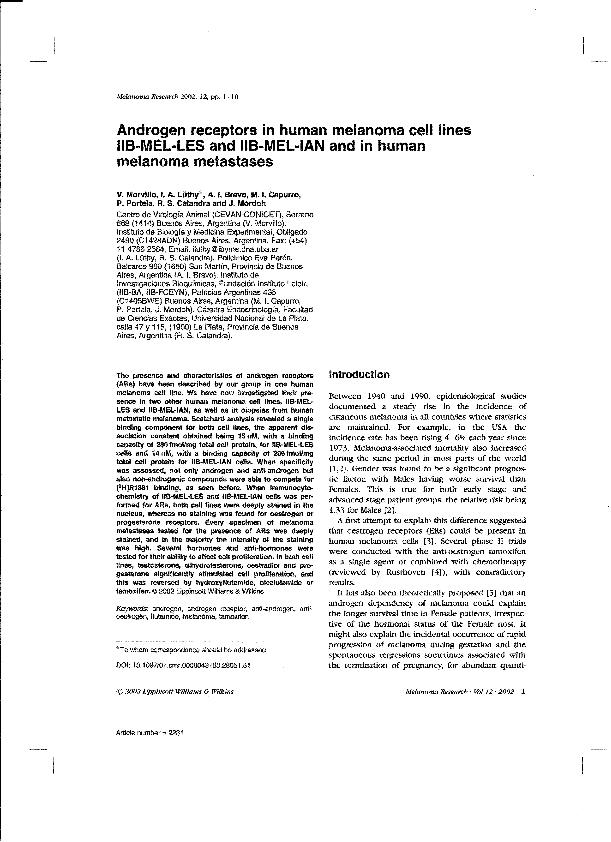Artículo
Androgen receptors in human melanoma cell lines IIB-MEL-LES and IIB-MEL-IAN and in human melanoma metastases
Morvillo, V.; Luthy, Isabel Alicia ; Bravo, A. I.; Capurro, M. I.; Portela, P.; Calandra, Ricardo Saul
; Bravo, A. I.; Capurro, M. I.; Portela, P.; Calandra, Ricardo Saul ; Mordoh, Jose
; Mordoh, Jose
 ; Bravo, A. I.; Capurro, M. I.; Portela, P.; Calandra, Ricardo Saul
; Bravo, A. I.; Capurro, M. I.; Portela, P.; Calandra, Ricardo Saul ; Mordoh, Jose
; Mordoh, Jose
Fecha de publicación:
12/2002
Editorial:
Lippincott Williams
Revista:
Melanoma Research
ISSN:
0960-8931
e-ISSN:
1473-5636
Idioma:
Inglés
Tipo de recurso:
Artículo publicado
Clasificación temática:
Resumen
The presence and characteristics of androgen receptors (AR) have been described by our group in one human melanoma cell line. We now investigated their presence in two other human melanoma cell lines, IIB-MEL-LES and IIB-MEL-IAN, as well as in biopsies of human metastatic melanoma. Scatchard analysis revealed a single binding component for both cell lines, the apparent dissociation constant obtained being 15 nM, with a binding capacity of 280 fmol/mg total cell protein for IIB-MEL-LES cells and of 14 nM with a binding capacity of 206 fmol/mg total cell protein for IIB-MEL-IAN. When specificity was assessed, as seen before, not only androgen and antiandrogen, but also non-androgenic compounds were able to compete for [3H]-R1881 binding. When immunocytochemistry of IIB-MEL-LES and IIB-MEL-IAN cells was performed for AR, both cell lines were deeply stained in the nucleus whereas no staining was found for oestrogen and progesterone receptors. Every specimen of melanoma metastases tested for the presence of AR was deeply stained, and the intensity of the staining was high in the majority. Several hormones and antihormones were tested for their ability to affect cell proliferation. On both cell lines, Testosterone, Dihydrotesterone, Oestradiol and Progesterone significantly stimulated cell proliferation, with reversion by Hydroxy-Flutamide, Casodex or Tamoxifen.
Archivos asociados
Licencia
Identificadores
Colecciones
Articulos(IBYME)
Articulos de INST.DE BIOLOGIA Y MEDICINA EXPERIMENTAL (I)
Articulos de INST.DE BIOLOGIA Y MEDICINA EXPERIMENTAL (I)
Articulos(IIBBA)
Articulos de INST.DE INVEST.BIOQUIMICAS DE BS.AS(I)
Articulos de INST.DE INVEST.BIOQUIMICAS DE BS.AS(I)
Citación
Morvillo, V.; Mordoh, Jose; Calandra, Ricardo Saul; Portela, P.; Capurro, M. I.; Bravo, A. I.; et al.; Androgen receptors in human melanoma cell lines IIB-MEL-LES and IIB-MEL-IAN and in human melanoma metastases; Lippincott Williams; Melanoma Research; 12; 6; 12-2002; 529-538
Compartir
Altmétricas



